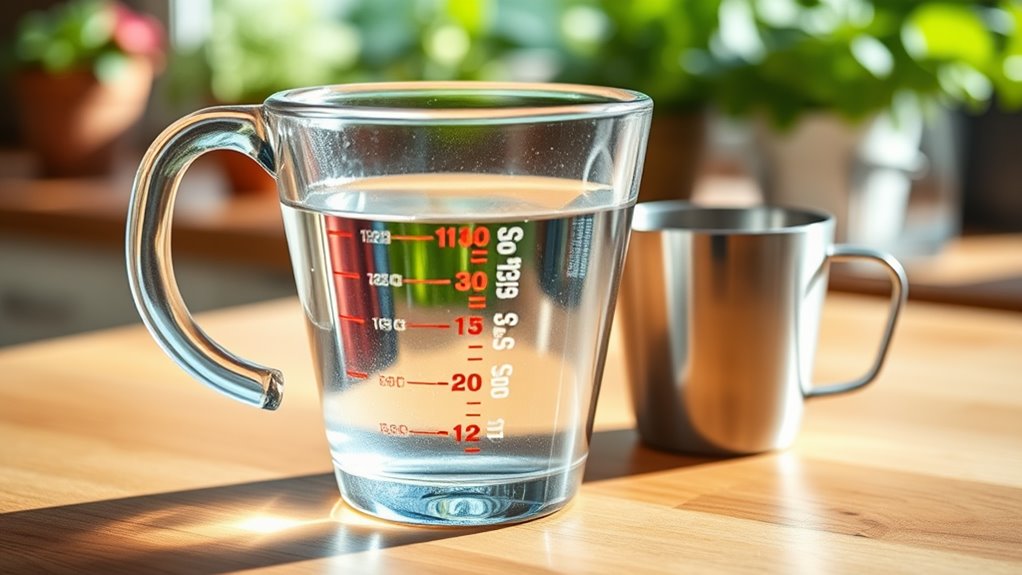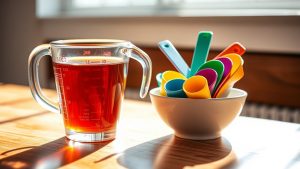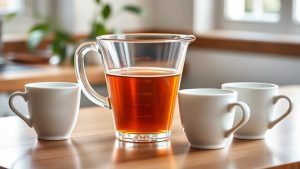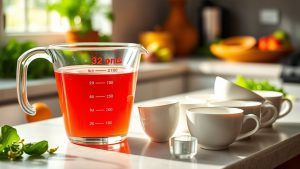
If you're asking how many cups are in 32 ounces, the answer is simple: it's 4 cups. Since 1 cup equals 8 fluid ounces, you can easily convert by dividing 32 by 8. This straightforward conversion highlights the consistency of liquid measurements, making cooking and baking more accurate. Understanding these measurements is essential for recipe success. Stick around to learn more about liquid and dry ingredient conversions and how they impact your culinary adventures.
When you're measuring liquids in the kitchen, understanding conversions is fundamental, especially when dealing with fluid ounces. If you find yourself with 32 fluid ounces of a liquid, you'll want to know how many cups that translates to. According to standard US measurement, 32 fluid ounces is equal to 4 cups. This conversion is straightforward because 1 cup equals 8 fluid ounces, and you can easily apply the formula: cups = fluid ounces ÷ 8. Therefore, when dividing 32 by 8, you arrive at the answer of 4 cups.
Understanding liquid conversions is key in the kitchen; 32 fluid ounces equals 4 cups, simplifying your cooking process.
This conversion holds true across all liquid ingredients. Whether you're measuring water, milk, or broth, the ratio remains consistent: 1 cup equals 8 fluid ounces. Unlike dry ingredients, which have varying densities and require different conversion factors, liquid measurements adhere to this uniform standard. For liquid ingredients, no matter the type, the process remains simple and dependable. Additionally, it's important to note that 1 fl oz = 1/8 c, which helps reinforce the conversion relationship between these two units.
In contrast, when you're working with dry ingredients, you'll notice that the situation becomes more complex. Dry ingredients like flour, sugar, and cocoa powder don't have a one-size-fits-all conversion rate. This variability is due to differences in density. For example, while 1 cup of all-purpose flour weighs about 4.4 ounces, 1 cup of granulated sugar is approximately 7 ounces. If you were to convert 32 ounces of flour into cups, you'd get roughly 7.25 cups, while 32 ounces of sugar would yield about 4.57 cups.
To avoid confusion, it's important to remember that the conversion from fluid ounces to cups is fixed for liquids. However, for dry ingredients, you should know the specific volume corresponding to each ingredient's weight. Some cooks use food scales to measure dry ingredients accurately, guaranteeing they get the right amount for their recipes. If you rely on volume measurements, using conversion charts is a practical way to navigate the complexities.
In the US customary measurement system, both cups and fluid ounces are significant to cooking. Cups serve as the primary unit for volume, particularly when dealing with liquids, while fluid ounces are useful for smaller quantities. This straightforward system simplifies the process when you're cooking or baking with liquid ingredients, allowing you to focus on combining flavors rather than recalibrating measurements.
Therefore, when you're measuring liquids, remember that 32 fluid ounces equals 4 cups. This knowledge not only streamlines your cooking process but also guarantees that you maintain accuracy in your recipes. Accurate measurements are essential for achieving the desired results, as even minor discrepancies can lead to significant variations in taste and texture.
Conclusion
To summarize, when you convert 32 ounces, you'll discover it equals 4 cups. This simple switch from ounces to cups makes measuring ingredients a breeze, bringing balance to your baking and cooking. By grasping this guideline, you'll navigate the world of measurements with confidence and clarity. So next time you pour, remember: 32 ounces is just 4 cups, cutting through confusion and creating culinary consistency. Embrace this easy equation and enhance your kitchen creations!



